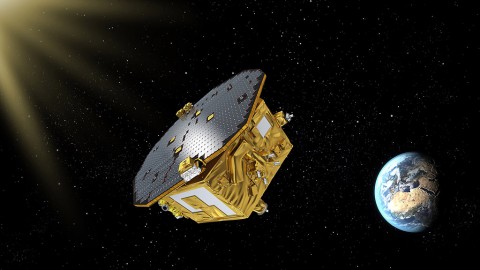Written by Elizabeth Landau
NASA’s Jet Propulsion Laboratory
 Pasadena, CA – While some technologies were created to make spacecraft move billions of miles, the Disturbance Reduction System has the opposite goal: To keep a spacecraft as still as possible.
Pasadena, CA – While some technologies were created to make spacecraft move billions of miles, the Disturbance Reduction System has the opposite goal: To keep a spacecraft as still as possible.
The thruster system, managed by NASA’s Jet Propulsion Laboratory, Pasadena, California, is part of the European Space Agency’s LISA Pathfinder spacecraft, which launched from Kourou, French Guiana on December 3rd, 2015 GMT (December 2nd PST).
LISA Pathfinder will test technologies that could one day allow detection of gravitational waves, whose effects are so miniscule that a spacecraft would need to remain extremely steady to detect them.

Now, LISA Pathfinder is on its way to Lagrange Point L1, about 930,000 miles (1.5 million kilometers) from Earth in the direction of the sun. L1 is a special point that a spacecraft can orbit while maintaining a nearly constant distance to Earth.
This month, scientists and engineers have been switching on LISA Pathfinder’s instruments to test them in space. This has included the Disturbance Reduction System instrument computer and thrusters.
The system uses colloid micronewton thrusters, which operate by applying an electric charge to small droplets of liquid and accelerating them through an electric field, to precisely control the position of the spacecraft. Thrusters that work this way had never been successfully operated in space before LISA Pathfinder launched.
As of January 10th, all eight identical thrusters, developed by Busek Co., Natick, Massachusetts, with technical support from JPL, passed their functional tests. The thrusters achieved their maximum thrust of 30 micronewtons, equivalent to the weight of a mosquito. This level of precision is necessary to counteract small forces on the spacecraft such as the pressure of sunlight, with the result that the spacecraft and the instruments inside are in near-perfect free-fall. A mission to detect gravitational waves would need that level of stability.
“We reached a major milestone with this technology development,” said Phil Barela, Disturbance Reduction System project manager at JPL. “The DRS is helping point the way to a system that could be used to detect gravitational waves in the future.”
Gravitational waves are one of the last unverified predictions from the theory of General Relativity, which Albert Einstein published about a century ago. Einstein wrote that as massive bodies accelerate, such as black holes, they produce distortions in space-time. Scientists are interested in observing and characterizing these ripples in space-time so that they can learn more about the astrophysical systems that produce them, and about gravity itself.
Proposed experiments to detect them from space, such as a future LISA mission, would need to measure how two freely-falling objects move ever so slightly, relative to each other, as a result of gravitational waves. In order to rule out any disturbances that could mask these waves, there must be a system to compensate for solar pressure and other factors. The Disturbance Reduction System on LISA Pathfinder will demonstrate this technology.
LISA Pathfinder will reach its final orbit on January 22nd, and begin science operations on March 1st. For the first phase of the mission’s science operations, a thruster technology system designed by the European Space Agency will be used. JPL’s Disturbance Reduction System will then take over in June or July, operating for 90 days.
LISA Pathfinder is managed by the European Space Agency. The spacecraft was built by Airbus Defence and Space, Ltd., United Kingdom. Airbus Defence and Space, GmbH, Germany, is the payload architect for the LISA Technology Package. The DRS is managed by JPL. The California Institute of Technology manages JPL for NASA.



